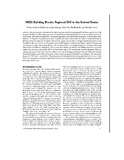| dc.contributor.author | Nedović-Budić, Z. | |
| dc.contributor.author | Knaap, G. | |
| dc.contributor.author | Budhathoki, R.N. | |
| dc.contributor.author | Cavrić, B. | |
| dc.date.accessioned | 2012-06-27T09:46:19Z | |
| dc.date.available | 2012-06-27T09:46:19Z | |
| dc.date.issued | 2009 | |
| dc.identifier.citation | Nedović-Budić, Z. et al. (2009) NSDI Building Blocks: Regional GIS in the United States, Journal of the Urban and Regional Information Systems Association, Vol. 21, No. 2, pp. 5 - 23 | en_US |
| dc.identifier.issn | 1045-8077 | |
| dc.identifier.uri | http://hdl.handle.net/10311/1022 | |
| dc.description.abstract | This paper presents an assessment of the regional capacity in implementing geographic information systems (GIS) and databases. We draw on a Web survey to determine the availability and assembly of spatial data at the metropolitan level in the United States. Information was sought from 388 planning organizations and regional agencies located in 349 metropolitan areas. Based on 116 responses (30 percent response rate), we generate descriptive statistics and run a regression model addressing the following aspects of the regional GIS capacity: data (contents, update, and assembly); technology (compatibility of software and data formats, data access, and the use of standards); people (staff, leadership commitment and support, regional communication and cooperation); policy (data sharing, funding, rules and responsibilities, and mandates/programs); and context (urban and regional issues and affluence). Although the survey reveals only a snapshot of a dynamic and evolving phenomenon, the results indicate that the status of metropolitan GIS in the United States may not be matching what is technically feasible. While the capacity is getting better over time, the process is relatively slow and the challenges of creating the base for building the National Spatial Data Infrastructure (NSDI) are persistent. Future research and practice should place more emphasis on the relationship between the NSDI and its installed base. Nurturing of networks and compatibilities among organizational entities at various levels, local and regional in particular, should be given priority in devising policies and programs for a useful and sustainable spatial data infrastructure. | en_US |
| dc.language.iso | en | en_US |
| dc.publisher | Urban and Regional Information Systems Association, http://www.urisa.org/ | en_US |
| dc.subject | Geographic information systems | en_US |
| dc.subject | GIS | en_US |
| dc.subject | Databases | en_US |
| dc.subject | Spatial data | en_US |
| dc.subject | Regional GIS capacity | en_US |
| dc.subject | United States | en_US |
| dc.title | NSDI building blocks: regional GIS in the United States | en_US |
| dc.type | Published Article | en_US |

